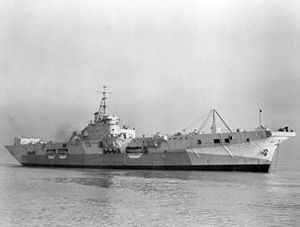 Pioneer at anchor, 3 February 1945
| |
| History | |
|---|---|
| Name | Pioneer |
| Ordered | 7 August 1942 |
| Builder | Vickers-Armstrong, Barrow-in-Furness |
| Laid down | 2 December 1942 |
| Launched | 20 May 1944 |
| Completed | 8 February 1945 |
| Decommissioned | 1954 |
| Identification | Pennant number: R76 |
| Fate | Sold for scrap, September 1954 |
| General characteristics | |
| Class and type | Colossus-class aircraft-maintenance ship |
| Displacement | |
| Length | 695 ft (211.8 m) |
| Beam | 80 ft 4 in (24.49 m) |
| Draught | 23 ft (7.0 m) (deep load) |
| Installed power |
|
| Propulsion | 2 × shafts; 2 × geared steam turbine sets |
| Speed | 25 knots (46 km/h; 29 mph) |
| Range | 12,000 nmi (22,000 km; 14,000 mi) at 14 knots (26 km/h; 16 mph) |
| Complement | 1,076 |
| Sensors and processing systems | 6 × Type 262 gunnery radars |
| Armament |
|
| Aircraft carried | None |
HMS Pioneer was a Colossus-class aircraft carrier built for the Royal Navy during World War II. She was modified whilst under construction into an aircraft maintenance carrier. The ship arrived in Australia in mid-1945 to support operations by the British Pacific Fleet against Japanese forces. She supported the British attacks on the Japanese Home Islands from mid-June until the end of the war in August from a base in the Admiralty Islands. The ship and her facilities were used to help repair Hong Kong's infrastructure in late 1945 and she returned to the UK in early 1946. Pioneer was immediately placed in reserve upon her arrival and she was sold in 1954 for scrap.